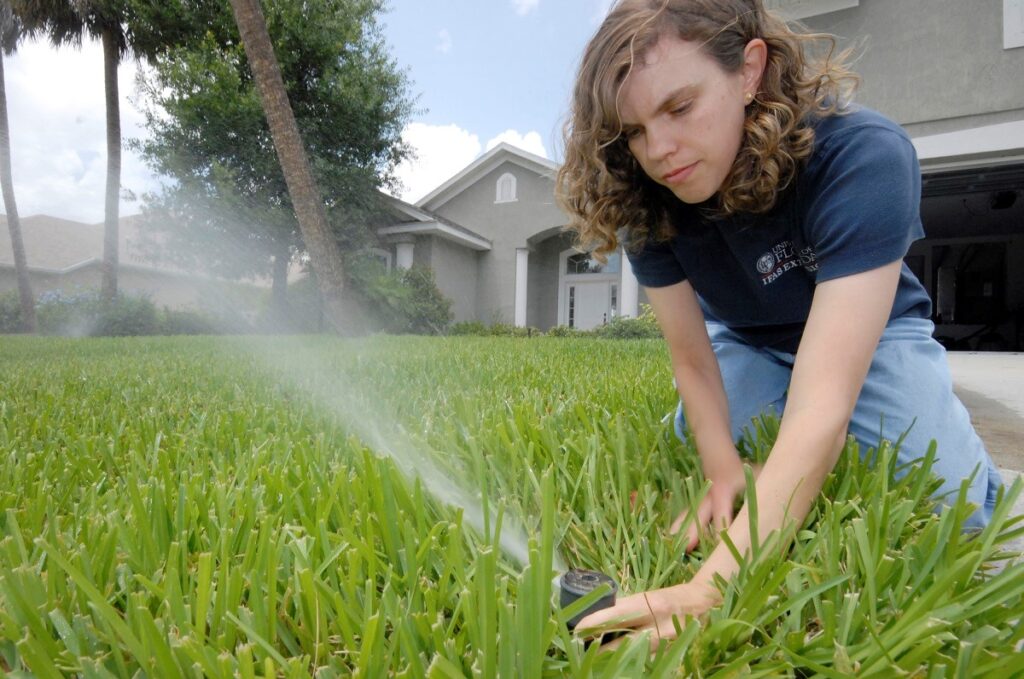Scientist Studying How Water Sources Influence Conservation Behaviors
by HEATHER MACHOVINA
Did you know as much as 50% of household water use goes toward landscape irrigation nationwide? That totals nearly 9 billion gallons of water per day just for watering outside the home, according to the U.S. Environmental Protection Agency (EPA). Drastic numbers like these are what drives Dr. Laura Warner’s research and extension work at the University of Florida (UF) in the Department of Agricultural Education and Communication (AEC). She focuses on helping Floridians adopt the most impactful and applicable conservation strategies to benefit natural resources and households by identifying ways to further understand individuals’ perceptions and educational needs relating to water.
So much research has been done already on water conservation, but Florida has a unique situation in that water users of residential homes have a variety of different sources for irrigation purposes. They could be using well water, city/public water, or reclaimed water to irrigate their lawns and landscapes. To date, no one had looked at whether the source of irrigation water was influencing individuals’ choices and behaviors.
Warner’s research team for this study involved Dr. Anil Kumar Chaudhary, an Assistant Professor in the Department of Agricultural Economics at Pennsylvania State University and a local researcher based in Fort Pierce, Dr. Lisa Krimsky. She is the Water Resources Regional Specialized Agent at UF/IFAS Extension.
There have been many efforts towards conservation, specifically on residential lawns and water use in the home landscape. Much of the focus is on water conservation efforts because irrigation of home landscapes is such a huge proportion of our at-home water usage. “Nearly 50% of the water we use in the home is for outdoor irrigation,” states Krimsky. “So it’s a prime opportunity for us to target water conservation and work towards conserving that limited resource that we have, especially during the dry season here in Florida.”
This is the first such research to examine the source of water and how it can change behaviors and efforts people put towards water conservation at their homes. The researcher team surveyed 3,310 Floridians through an online poll. Participants revealed whether they used city/public water, well water, or reclaimed water. Results of this study were based on three years of collected data.
“What we found,” mentions Krimsky, “is that there were indeed differences in terms of conservation behaviors that individuals are likely to partake in, based on their source of water.” Overall, there was an association between the water source and engagement in nine conservation behaviors. Here’s the breakdown. Well water users tend to be the least conservative. They are less likely to use recycled water, use a rain sensor, calibrate their sprinklers, or use smart irrigation controls, which all help with conservation. Reclaimed water users were obviously more likely to use recycled water, but less likely to keep up with irrigation maintenance, such as turning off zones or capping irrigation heads for established plants. Finally, city/public water users showed the strongest water conservation efforts.
There are a lot of perceptions based on water as a resource. There’s been studies to show that the cost of city water can influence people’s usage rates versus unmetered well water residents. Reclaimed water can be an expensive option too, but perhaps could be perceived as an unending supply because it is recycled water, therefore leading individuals to use more and conserve less. It’s not surprising that this study also confirms that those communities more likely to have access to city/public water or reclaimed water are also more likely to live in HOAs (Home Owners Associations), more likely to hire landscaping companies, and more likely to irrigate their landscapes frequently. This all influences water conservation and landscaping practices.
“These findings are important when talking to communities and trying to encourage behaviors, like water conservation,” says Krimsky. “Understanding what behaviors people are more likely to accept, what behaviors they’re already doing, and understanding what behaviors they’re not doing, because that could be an opportunity to improve as well.”
These findings are critical as scientists and policy makers consider how to conserve water as the population of Florida and the rest of the nation grows. It will influence future educational programming targeted at water conservation behaviors based on water use in our communities.

